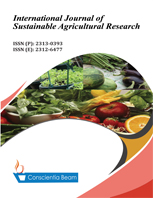Heterosis for Nitrogen Fixation and Seed Yield and Yield Components in Chickpea (Cicer arietinum L.)
DOI:
https://doi.org/10.18488/journal.70.2017.42.50.57Abstract
Chickpea is one of the most cultivated grain legumes in Ethiopia for grain production and amelioration of soil fertility with less attention in research on N-fixation. Therefore, this study was conducted to estimate the magnitude of heterosis for nitrogen fixation and yield and yield associated traits in chickpea (Cicer arietinum L.). Six F1 crosses obtained from crossing of four parents (two nodulated and non-nodulated) in a half diallel fashion were evaluated in 2014/15 season in lath house using Randomized Complete Block Design (RCBD) with two replications at Debre Zeit Agricultural Research Center. Significant (P<0.05) differences were exhibited among entries for all traits studied. Considering all traits, relative to the mid parent (MPH), better parent (BPH) and standard heterosis (SH) in percent ranged from 0.009 to 59.8, 0.009 to39.9 and 0.009 to58.8, respectively. The highest degrees of MPH were noted for nodule dry weight and of BPH and SH were noted for number of pods per plant, while the lowest was observed for grain yield (0.009). The hybrid obtained from nodulated parents (ICC5003 x ICC19180) showed high heterosis for number of nodule on the basis of MPH and BPH, while ICC4918x ICC19181 exhibited low heterotic effect which exhibited positive and significant MPH for nitrogen fixed in grain, BPH for seed filling duration and SH for days to 50% flowering, days to 90% maturity and shoot dry weight at maturity traits.

